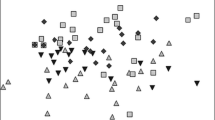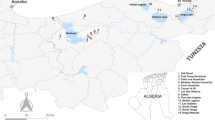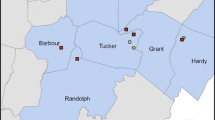Abstract
Constructed wetlands may compensate to some degree for the impact of the loss of natural wetlands on aquatic biodiversity. However, information is lacking on the relative value of artificial wetlands and comparable natural wetlands for freshwater turtles. I contrasted the population structure, diet and body growth of Australian eastern long-necked turtles (Chelodina longicollis) in artificial and natural ponds in farmland settings. Turtle populations in the artificial ponds had a more even distribution of body size, and a much larger proportion of young individuals, than those in the natural ponds, suggesting that the artificial ponds were important recruitment sites. Diet differed little between the two types of ponds, being greatly dominated by aquatic insects in both cases. However, body growth of juvenile turtles was on average more rapid in the artificial ponds, possibly because they were generally permanent, unlike the natural ponds. These findings suggest that artificial farm ponds are valuable habitats for C. longicollis, which may foster population recruitment that counters the effects of introduced nest predators and road mortality.


Similar content being viewed by others
Data Availability
Data are available from the author on reasonable request.
Code availability
Not applicable.
References
Addinsoft, 2021. XLSTAT statistical and data analysis solution. Addinsoft, Long Island, NY, U.S.A. https://www.xlstat.com.
Armstrong, G. & D. T. Booth, 2005. Dietary ecology of the Australian freshwater turtle (Elseya sp.: Chelonia: Chelidae) in the Burnett River, Queensland. Wildlife Research 32: 349–353.
Arthur, A. D., S. Henry & A. Reid, 2010. Influence of revegetation on predation rates by introduced red foxes (Vulpes vulpes) in south-eastern Australian farmland. Austral Ecology 35: 919–928.
Bailey, P. C. E., 1987. Abundance and age-specific spatial and temporal distribution in two waterbug species, Anisops deanei (Notonectidae) and Ranatra dispar (Nepidae) in three farm dams in South Australia. Oikos 49: 83–90.
Barlow, C. G., M. Leedow & R. McLoughlin, 1982. Macroinvertebrate sampling using a dredge net in a farm dam in southwestern New South Wales. Australian Zoologist 21: 97–104.
Bellio M. G., R. T. Kingsford & S. W. Kotagama, 2009. Natural versus artificial- wetlands and their waterbirds in Sri Lanka. Biological Conservation 142: 3076–3085.
Brainwood M. & S. Burgin S, 2009. Hotspots of biodiversity or homogeneous landscapes? Farm dams as biodiversity reserves in Australia. Biodiversity and Conservation 18: 3043–3052.
Brand, A. B. & J. W. Snodgrass, 2010. Value of artificial habitats for amphibian reproduction in altered landscapes. Conservation Biology 24: 295–301.
Bubiková, K. & R. Hrivnák, 2018. Artificial ponds in central Europe do not fall behind the natural ponds in terms of macrophyte diversity. Knowledge and Management of Aquatic Ecosystems 419: e8.
Burgin, S., S. Emerton & M. Burgin, 1999. A comparison of sample and total census data for a population of the eastern longneck turtle Chelodina longicollis in a farm dam north-west of Sydney, New South Wales. Australian Zoologist 31: 161–165.
Campbell, B. D., R. J. Haro & W. B. Richardson, 2009. Effects of agricultural land use on chironomid communities: comparisons among natural wetlands and farm ponds. Wetlands 29: 1070–1080.
Canals, R. M., V. Ferrer, A. Iriarte, S. Cárcamo, L. San Emeterio & E. Villanueva, 2011. Emerging conflicts for the environmental use of water in high-valuable rangelands. Can livestock water ponds be managed as artificial wetlands for amphibians? Ecological Engineering 37: 1443–1452.
Caputo, F. P. & R. C. Vogt, 2008. Stomach flushing vs. fecal analysis: the example of Phrynops rufipes (Testudines: Chelidae). Copeia 2008: 301–305.
Carter, A. & G. W. Luck, 2013. Fox baiting in agricultural landscapes: preliminary findings on the importance of bait-site selection. Wildlife Research 40: 184–195.
Casanova, M. T., A. Douglas-Hill, M. A. Brock, M. Muschal & M. Bales, 1997. Farm ponds in New South Wales, Australia: relationship between macrophyte and phytoplankton abundances. Marine and Freshwater Research 48: 353–60.
Casas J. J., J. S. Sánchez-Oliver, A. Sanz, M. Furné, C. Trenzado, M. Juan., M. Paracuellos, M. D. Suárez, F. Fuentes, I. Gallego, C. Gil & J. J. Ramos-Miras, 2011. The paradox of the conservation of an endangered fish species in a Mediterranean region under agricultural intensification. Biological Conservation 144: 253–262.
Chessman, B. C., 1978. Ecological studies of freshwater turtles in south-eastern Australia. Ph.D. thesis, Monash University, Melbourne, Australia.
Chessman, B. C., 1984. Food of the snake-necked turtle, Chelodina longicollis (Shaw) (Testudines: Chelidae) in the Murray Valley, Victoria and New South Wales. Australian Wildlife Research 11: 573–578.
Chessman, B. C., 2011. Declines of freshwater turtles associated with climatic drying in Australia’s Murray–Darling Basin. Wildlife Research 38: 664–671.
Chessman. B. C., 2018a. Freshwater turtle hatchlings that stay in the nest: strategists or prisoners? Australian Journal of Zoology 66: 34–40.
Chessman, B. C., 2018b. Slow and unsteady: growth of the Australian eastern long-necked turtle near the southern end of its natural range. Australian Journal of Zoology 66: 77–83.
Dalbeck L. & K. Weinberg, 2009. Artificial ponds: a substitute for natural beaver ponds in a Central European Highland (Eifel, Germany)? Hydrobiologia 630: 49–62.
Davidson, N. C., 2014. How much wetland has the world lost? Long-term and recent trends in global wetland area. Marine and Freshwater Research 65: 934–941.
Davis, A. M. & A. R. Moore, 2016. Conservation potential of artificial water bodies for fish communities on a heavily modified agricultural floodplain. Aquatic Conservation: Marine and Freshwater Ecosystems 26: 1184–1196.
Declerck, S., T. de Bie, D. Ercken, H. Hampel, S. Schrijvers, J. van Wichelen, V. Gillard, R. Mandiki, B. Lossom, D. Bauwens, S. Keijers, W. Vyverman, B. Goddeeris, L. de Meester, L. Brendonck & K. Martens, 2006. Ecological characteristics of small farmland ponds: associations with land use practices at multiple spatial scales. Biological Conservation 131: 523–532.
Dufrêne, M., & P. Legendre, 1997. Species assemblages and indicator species: the need for a flexible asymmetrical approach. Ecological Monographs 67: 345–366.
Dupuis-Desormeaux, M., C. Davy, A. Lathrop, E. Followes, A. Ramesbottom, A. Chreston & S. E. MacDonald, 2018. Colonization and usage of an artificial urban wetland complex by freshwater turtles. PeerJ 6: e5423.
Español, C., B. Gallardo, F. A. Comín & M. R. Pino, 2015. Constructed wetlands increase the taxonomic and functional diversity of a degraded floodplain. Aquatic Sciences 77: 27–44.
Georges, A., R. H. Norris & L. Wensing, 1986. Diet of the freshwater turtle Chelodina longicollis (Testudines: Chelidae) from the coastal dune lakes of the Jervis Bay Territory. Australian Wildlife Research 13: 301–308.
Giosa, E., C. Mammides & S. Zotos, 2018. The importance of artificial wetlands for birds: a case study from Cyprus. PLoS ONE 13: e0197286.
Grayson, R. B., C. J. Gippel, B. L. Finlayson & B. T. Hart, 1997. Catchment-wide impacts on water quality: the use of 'snapshot' sampling during stable flow. Journal of Hydrology 199: 121–134.
Hamilton, A. J., C. Conort, A. Bueno, C. G. Murray & J. R. Grove, 2017. Waterbird use of farm dams in south-eastern Australia: abundance and influence of biophysical and landscape characteristics. Avian Research 8: e2.
Hartwig, T. S. & E. Kiviat, 2007. Microhabitat association of Blanding's turtles in natural and constructed wetlands in southeastern New York. Journal of Wildlife Management 71: 576–582.
Hazell, D., J.-M. Hero, D. Lindenmayer & R. Cunningham, 2004. A comparison of constructed and natural habitat for frog conservation in an Australian agricultural landscape. Biological Conservation 119: 61–71.
Hrivnák, R., J. Kochjarová, H. Oťaheľová, P. Paľove-Balang, M. Slezák & P. Slezák P, 2014. Environmental drivers of macrophyte species richness in artificial and natural aquatic water bodies–comparative approach from two central European regions. Annales de Limnologie 50: 269–278.
Hu, S., Z. Niu, Y. Chen, L. Li & H. Zhang, 2017. Global wetlands: potential distribution, wetland loss, and status. Science of the Total Environment 586: 319–327.
Kennett, R. M. & A. Georges, 1990. Habitat utilization and its relationship to growth and reproduction of the eastern long-necked turtle, Chelodina longicollis (Testudinata: Chelidae), from Australia. Herpetologica 46: 22–33.
Kingsford, R. T., A. Basset & L. Jackson, 2016. Wetlands: conservation’s poor cousins. Aquatic Conservation: Marine and Freshwater Ecosystems 26: 892–916.
Legler, J. M., 1960. A simple and inexpensive device for trapping aquatic turtles. Proceedings of the Utah Academy of Science, Arts, and Letters 37: 63–66.
Legler, J. M., 1977. Stomach flushing: a technique for chelonian dietary studies. Herpetologica 33: 281–284.
Malerba, M. E., Wright, N. & P. I. Macreadie, 2021. A continental-scale assessment of density, size, distribution and historical trends of farm dams using deep learning convolutional neural networks. Remote Sensing 13: e319.
Magnusson, W. E., A. C. Lima, V. L. Costa, & O. P. Lima, 1997. Growth of the turtle, Phrynops rufipes, in central Amazonia, Brazil. Chelonian Conservation and Biology 2: 576–580.
McCune, B. & M. J. Mefford, 2016. PC-ORD. Multivariate Analysis of Ecological Data. Version 7. MjM Software Design, Gleneden Beach, Oregon, U.S.A.
Meathrel, C. E., P. J. Suter & N. M. Radford, 2002. Niche segregation between three species of freshwater turtle in a large billabong during flood. Victorian Naturalist 119: 160–173.
Meathrel, C. E., P. J. Suter & S. Reid, 2004. Habitat and dietary preferences of freshwater turtles in ephemeral billabongs on the Ovens River, north-east Victoria. Victorian Naturalist 121: 4-14.
Mielke, P. W. Jr, K. J. Berry & E. S. Johnson, 1976. Multi-response permutation procedures for a priori classifications. Communications in Statistics–Theory and Methods 5: 1409–1424.
Nathan, R. & L. Lowe, 2012. The hydrologic impacts of farm dams. Australian Journal of Water Resources 16: 75–83.
Newey, W.K. & K. D. West, 1987. A simple, positive semi-definite, heteroskedasticity and autocorrelation consistent covariance matrix. Econometrica 55: 703–708.
Nickerson, M. A., J. C. Mitchell & B. M. Glorioso, 2019. The importance of turtle populations to wetland restoration in the Upper Mississippi Embayment of the Mississippi Alluvial Valley. Wetlands Ecology and Management 27: 683–692.
Reyne, M., M. Nolan, H. McGuiggan, A. Aubry, M. Emmerson, F. Marnell & N. Reid, 2021. Artificial agri-environment scheme ponds do not replicate natural environments despite higher aquatic and terrestrial invertebrate richness and abundance. Journal of Applied Ecology 58: 304–315.
Ruello, N. V., 1975. A small beam trawl for sampling surface or demersal and benthic organisms. Bulletin of the Australian Society for Limnology 6: 9–16.
Ryan, M. & S. Burgin, 2007. Gone walkabout? Movement of the eastern long-necked turtle Chelodina longicollis from farm dams in northwest peri-urban Sydney (Australia). Journal of Biological Research–Thessaloniki 8: 119–127.
Samways, M. J., C. Deacon, G. J. Kietzka, J. S. Pryke, C. Vorster & J. P. Simaika, 2020. Value of artificial ponds for aquatic insects in drought-prone southern Africa: a review. Biodiversity and Conservation 29: 3131–3150.
Santori, C., R.-J. Spencer, J. U. Van Dyke & M. B. Thompson, 2018. Road mortality of the eastern long-necked turtle (Chelodina longicollis) along the Murray River, Australia: an assessment using citizen science. Australian Journal of Zoology 66: 41–49.
Schlaepfer, M. A., M. C. Runge & P. W. Sherman, 2002. Ecological and evolutionary traps. Trends in Ecology and Evolution 17: 474-480.
Sirami, C., D. S. Jacobs & G. S. Cumming, 2013. Artificial wetlands and surrounding habitats provide important foraging habitat for bats in agricultural landscapes in the Western Cape, South Africa. Biological Conservation 164, 30–38.
Spencer, R.-J., 2018. How much long-term data are required to effectively manage a wide-spread freshwater turtle? Australian Zoologist 39: 568–575.
Stahlschmidt, P., A. Pätzold, L. Ressl, R. Schulz & C. A. Brühl, 2012. Constructed wetlands support bats in agricultural landscapes. Basic and Applied Ecology 13: 196–203.
VanDyke, J. U., B. D. Ferronato & R.-J. Spencer, 2018. Current conservation status of Australian freshwater turtles. Australian Journal of Zoology 66: 1–3.
Acknowledgements
Early stages of the data collection were part of a Ph.D. programme at Monash University supervised by Dr P. S. Lake, Associate Professor A. K. Lee and Professor J. W. Warren. The author also thanks landowners for site access, the former Victorian Department of Conservation and Natural Resources and its predecessors for research permits, and anonymous reviewers for comments that improved the manuscript.
Funding
The research was funded by the author.
Author information
Authors and Affiliations
Corresponding author
Ethics declarations
Conflict of interest
The author declares that he has no conflict of interest.
Ethical approval
Ethics approval was not applicable in early years of data collection, and in later years was provided by the former Monash University Standing Committee on Ethics in Animal Experimentation.
Consent to participate
Not applicable.
Consent for publication
Not applicable.
Additional information
Handling editor: Stuart Halse
Publisher's Note
Springer Nature remains neutral with regard to jurisdictional claims in published maps and institutional affiliations.
Rights and permissions
About this article
Cite this article
Chessman, B.C. The value of artificial farm ponds to Australian eastern long-necked turtles. Hydrobiologia 849, 113–120 (2022). https://doi.org/10.1007/s10750-021-04715-6
Received:
Revised:
Accepted:
Published:
Issue Date:
DOI: https://doi.org/10.1007/s10750-021-04715-6




